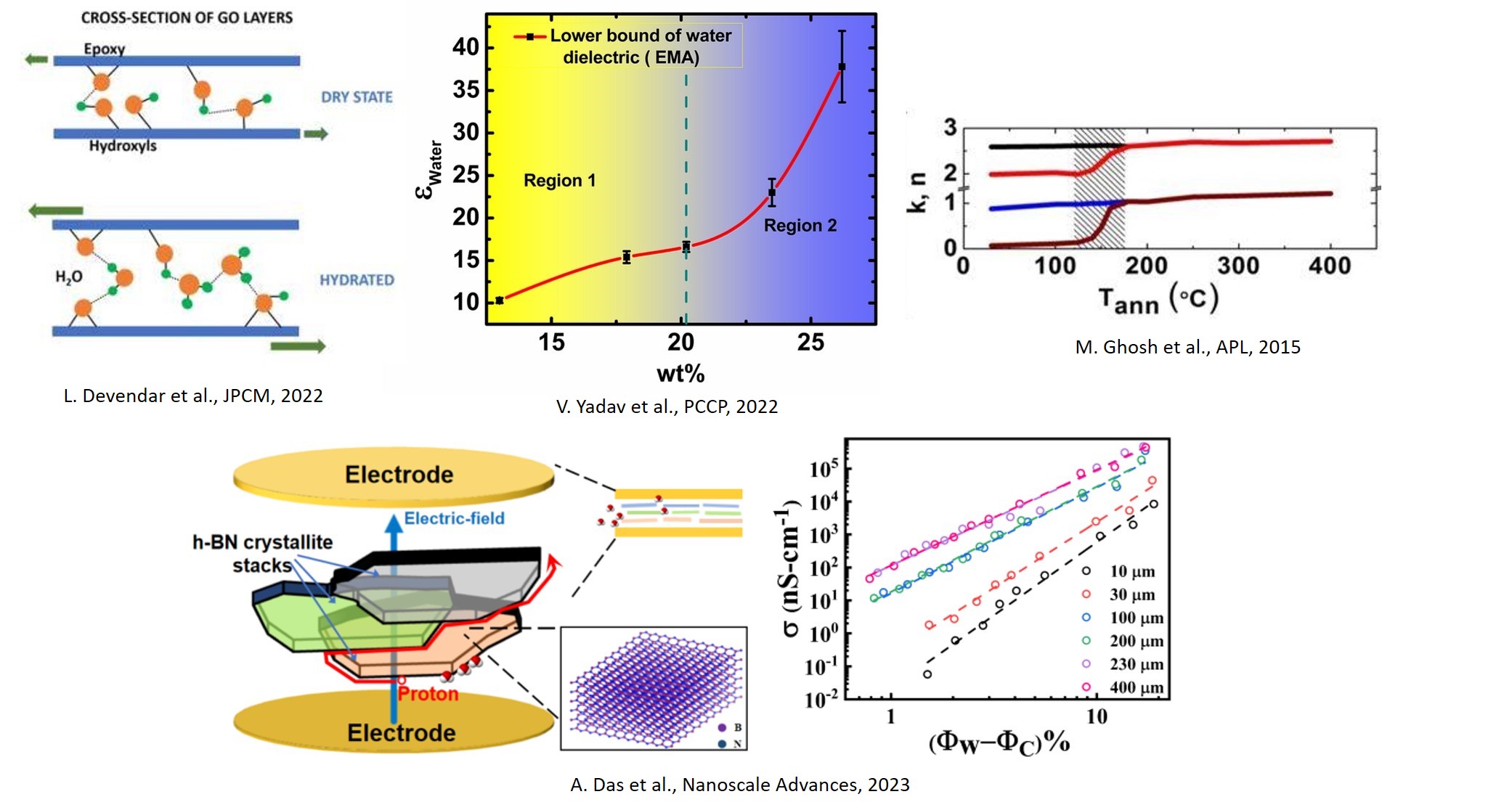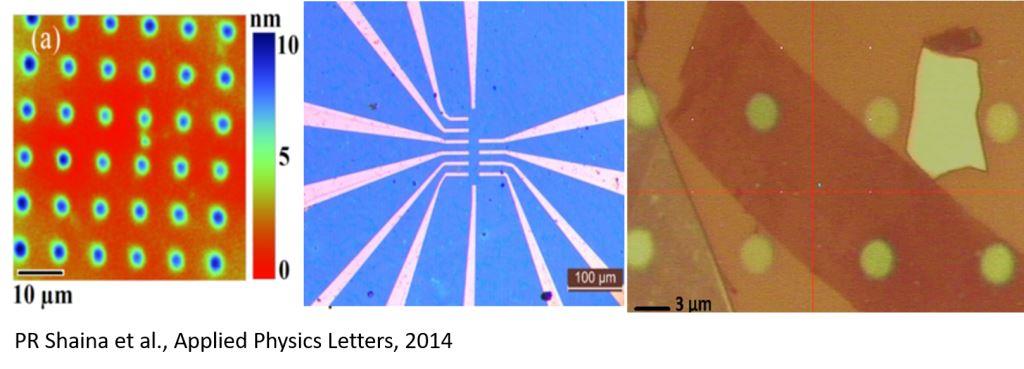What is amazing about the thermal conductivity of 2D materials is the wide range of tuneability. Graphene has among the highest known thermal conductivities and values exceeding 5000 mW/m.K in suspended single-layer graphene have been reported. Results from different groups have reported significant variations in these values. The role of underlying factors limiting thermal conductivity as well as the dominant type of phonon carriers are still not well understood. In one study, we investigated the role of twist angles on the heat transport in graphene stacks (See Akash Mohapatra, MSR Rao and Manu Jaiswal, Carbon, 201, 120, 2033). Link In another work, we looked at the role of local curvature on thermal transport: Akash Mohapatra et al., Nanoscale Adv., 3, 1708-1716, 2021 Link. The experimental technique used in these experiments was Raman optothermal method supported by finite element analysis. With appropriate engineering, graphene in the form of ultra-light aerogels shows ultralow thermal conductivity that reaches down to few mW/m.K and these have been studied by us using transient and steady-state electrothermal techniques. The aerogels are promising for thermal insulator applications. Most materials expand upon heating. Graphite is one material which undergoes in-plane contraction on heating at ambient temperatures and thus has a negative thermal expansion coefficient (TEC). This property of graphite is known since the 1940s. What comes as a surprise is that TEC of graphene (single-layer of graphite) is hotly contested, and not just for its magnitude but also for its sign. Our published work: P R Shaina et al J. Phys.: Condens. Matter 28 085301 2016 Link explores the reason behind the literature discrepancies in graphene's TEC and conveys the importance of factoring the substrate interaction and strain profile of graphene membranes in the estimation of TEC. Wrinkles, a universal feature of thin flexible membranes that range from curtains and human skin to graphene, holds the key to understanding the TEC of graphene. Ultrathin 2D materials are often cast on thick supporting substrates for nanoelectronics device applications. The lateral heat flow within a 2D material, molybdenum disulfide, is shown to be strongly modulated by the underlying substrate. Heat is carried within a single layer of molybdenum disulfide by quantized atomic vibrations called phonons. Theoretical predictions have indicated that these phonons are scattered by phonons of the underlying substrate. However, the heat flows in both these media are comparable, and the respective contributions are experimentally difficult to discern. Further, lattice strain and atomic-scale defects are frequently present in these 2D materials, and they also influence the heat transport. Through controlled experiments relying on a spectroscopic technique, we have unraveled the role of substrate properties in modulating the heat flow in the 2D layer. Specifically, heat conducts four times faster when a single layer of molybdenum disulfide is placed on a crystal of sapphire than on disordered silica. The study provides valuable insights into thermal engineering at the nanoscale. This study was done in collaboration with Prof. Jayakumar Balakrishnan, IIT Palakkad. See Link.

Bulk water is an interesting and a not-well-understood system in its own right. The confinement of water further drastically modifies its physical properties, both in terms of structure and hydrogen bonding as well as dynamics or flow. Two-dimensional systems provide a suitable matrix to trap water and study its properties. We have used multiple techniques that include electro-impedance spectroscopy, dynamic vapor sorption, spectroscopic ellipsometry, infrared spectroscopy, feed-permeate diffusion cell, gravimetry and pressure-driven filtration apparatus to investigate the behaviour of confined water and ions. In our recent work, we have shown that confined water behaves distinctly differently in a hydrophilic environment than in a hydrophobic one. The lower bound for the dielectric constant of confined water is estimated to be ε_water > 17. This number is much lower than the dielectric constant of bulk water (80) but much higher than the pure electronic contribution to polarization (~ 1.8). See our work: Dielectric response and proton transport in water confined in graphene oxide, Vikas Yadav et al., Phys. Chem. Chem. Phys. (PCCP), (published online) 2022 Link In a previous study from our group, the optical properties of graphene oxide in the presence of water intercalation were studied (see Ghosh et al 2015 Applied Physics Letters 106 241902) Link. We demonstrated that the expulsion of interfacial water resulted in abrupt changes of the refractive index of GO across a narrow annealing temperature interval. Is the density of confined water different than that of bulk, is a fascinating question we partly dwelt on. The nature of nanoscopic water conduction pathways in graphene oxide were studied in Ravishankar et al 2019 Journal of Applied Physics 125 144304 Link. In a recent study, we have demonstrated the modification of in-plane elastic moduli of graphene oxide in the presence of intercalated water, which can be attributed to role of modified hydrogen bonded network between adjacent graphene oxide sheets. (see L. Devendar et al., Journal of Physics: Condensed Matter, 34, 025001, 2022). Link Another fascinating system is hexagonal boron nitride (h-BN). We reported anomalous features of percolative proton transport in h-BN membranes (see Anjan Das et al., Nanoscale Advances, 2023) Link

In these studies, we look at the interplay of electrical transport and mechanical response of layered 2D materials on flexible substrates. Try stretching a piece of polyethene. Characteristic quasi-periodic arrays of wrinkles are formed whose crests and troughs are aligned along the direction of strain. Universal laws of scaling describe the wrinkle formation in objects ranging from macroscopic ones (such as curtains, human skin) down to thin films and atomically-thin films like single-layer graphene. However, in microstrips of layered graphene, we found a breakdown of this universal wrinkling behaviour. The orientation of the wrinkle patterns changed when the width of interconnects was reduced below a certain value, leading to irreversible response when the system is subject large strains. Wrinkle patterns directly set the electromechanical performance limits of strained graphene interconnects on flexible substrates. More details can be found in our research article: Tushar Sakorikar et al., Carbon, 158, 864, 2020. View Link

It is possible to design and control the “shape” of atomically-thin membranes on corrugated substrates. Depending on the aspect ratio of the corrugations as well as the interaction energy with the substrate, these membranes can undergo a phase transition from a completely pinned state where they follow the contours of the substrate to a partially depinned state where it is energetically favourable to locally delaminate. Thus, an unprecedented control on the morphology of the membrane can be realized. Lithography is 3-dimensional, allowing the patterning of structures with a given lateral dimension and aspect ratio. To study this physics of snap-through instability, we developed novel electron-beam lithography resist patterns that swell vertically by up to 10-times in ambient. We then studied how graphene membranes adapt to the nanoscale substrate corrugation with widely in-situ tuneable aspect ratio. Read this work in detail: P R Shaina and Manu Jaiswal, 2014 Appl. Phys. Lett. 105 193103. View Link

Here is a link to a popular article on conducting polymers: Manu Jaiswal and R. Menon 2006 Polymer International 55 1371 Link We developed a crack-based alcohol sensor based on the conducting polymer PEDOT: PSS, which far outperforms the commercial breath analyzer used by our local traffic police. See our article for details: Nanostructuring mechanical cracks in a flexible conducting polymer thin film for ultra-sensitive vapor sensing, Biporjoy Sarkar, Dillip K. Satapathy and Manu Jaiswal, Nanoscale, 2019,11, 200-210.); this work has also been filed for patent. Link
